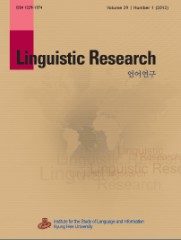A moraic analysis of lateral approximant in Korean
A moraic analysis of lateral approximant in Korean
- 경희대학교 언어정보연구소
- 언어연구
- 제40권 제1호
-
2023.0367 - 91 (25 pages)
-
DOI : 10.17250/khisli.40.1.202303.003
- 15

The main purpose of this article is to present an account of symmetrical effect of Korean lateralization. We claim that the phenomenon can be adequately dealt with given our assumption that lateral approximant carries a mora and tends to form a geminate structure to preserve the mora. Syllable Contact Law as a universal OT constraint is rejected in favor of a geminate-inducing constraint. The constraint to the effect that a sequence of sonorant coronals is prohibited will be eliminated, too. We do not need to postulate two separate markedness constraints that militate against nl or ln sequence in Korean. By so doing, our basic intuition is captured that the tendency to avoid sequences of nl or ln results from one and the same constraint. When adjacent to labial or dorsal consonants, lateral approximant do not go through lateralization or gemination since it is to violate the high-ranking faithfulness of non-coronals. Some aspects of l-nasalization and word-initial l-avoidance will also be discussed. It is interesting to note that both of them seem to lend further support to our assumption about the geminate status of lateral approximant in Korean.
1. Introduction
2. Paradigm
3. Proposal
4. Analysis
5. Further discussion
6. Earlier OT treatments
7. Conclusion
References
(0)
(0)